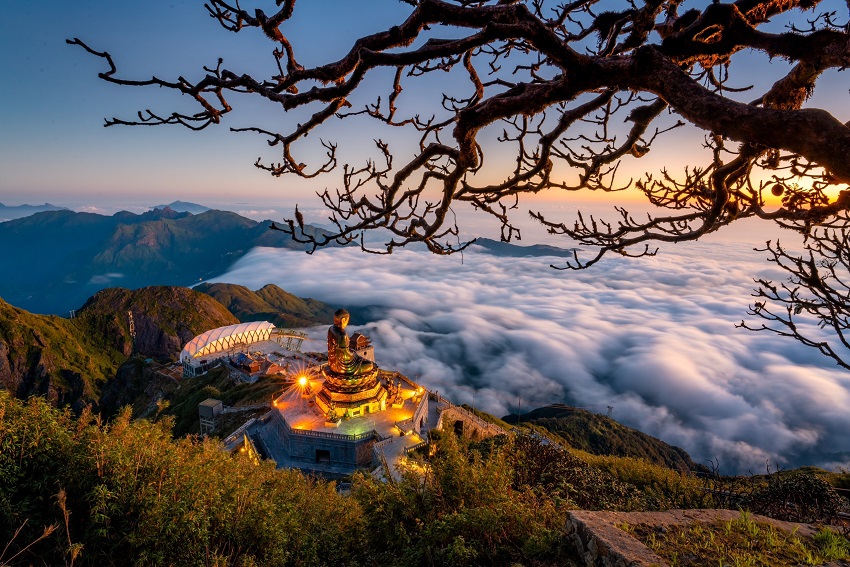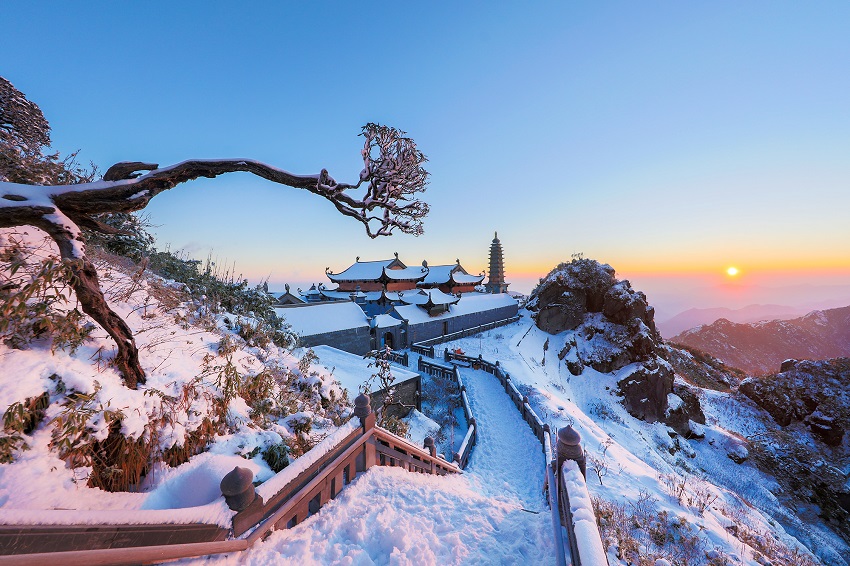"We've finally arrived!" exclaimed my Thai companion, Jiratha Jamsuwan, as we arrived at the reception lobby of Lady Hill Resort, a newly-opened 5-star resort located directly opposite the legendary Fansipan Mountain of Sapa Town, Lao Cai Province.
We had made a very long journey in the sleeper bus to get here, with the purpose of "chasing clouds" and conquering Fansipan Peak - the roof of Indochina.

The Fansipan mountain is known as the "gateway to the sky" in Vietnam. Photo: Nguyen Minh Tu
Symbolic Mountain of Indochina
Climbing Mount Fansipan is considered the pinnacle of any adventurous expedition for those enchanted by the allure of Southeast Asia and the majestic beauty of northwest Vietnam.
Vietnam does not have a mountain as a national symbol like Japan with Mount Fuji or Switzerland with the Matterhorn, but if there is one mountain that the Vietnamese people can be proud of, it is undoubtedly Mount Fansipan - the highest peak in the former French Indochina (including Vietnam, Cambodia and Laos).
It's no coincidence that the Vietnamese have a saying: "Everyone has their own Fansipan to climb", as a metaphor for their greatest dreams in life.
Fansipan, also known as Hua Xi Pan in the local language, means "the swaying giant rock". According to the Vietnam Institute of Geological Sciences, the mountain is a majestic granite rock that rose from the depths of the earth more than 250 million years ago.
Northwest Vietnam is known for its treacherous terrain, considered one of the most challenging in Southeast Asia. Nestled in this rugged landscape, Fansipan is part of the Hoang Lien Son mountain range, which boasts the most complex topography in the northwest region. According to various sources, the Hoang Lien Son mountain range is also considered the southeastern terminus of the magnificent Himalayas.

The famous mountain is known as the roof of Indochina. Photo Le Viet Khanh
Hidden Paradise
The journey to conquer Mount Fasipan began early in the morning of our second day in Sapa, with the goal of fulfilling Jiratha's dream of exploring the legendary peak.
In the past, conquering the Roof of Indochina was an endeavor reserved for the adventurous souls who had the courage and physical stamina to trek for days through dense forests to finally reach the summit.
Today, modern technology has made it much easier. Fansipan has enticed foreign travelers with the lure of exploring its wonders within a day.
Riding a cable car to the thousands of meters of altitude, we were greeted by a beautiful natural scenery. Far ahead of us is a breathtaking panorama where the lines between land and sky are blurred by the rolling sea of clouds. At our feet, a dreamlike landscape of golden terraced rice fields, green forests and waterfalls gently cascading down from above. The destination surpasses the splendor found anywhere else in Vietnam.

The beauty of the “gold season” of Muong Hoa Valley, Sapa Town in autumn. Photo: Chu Nga
After a little more than an hour's walk and a cable car ride, we reached the top of Fansipan. The swirling clouds and treacherous forest have given the mountain a breathtaking and surreal beauty.
Through the haze like a thin layer of chiffon, we can also catch a glimpse of spiritual structures that embody the essence of ancient Vietnamese temples from the 15th and 16th centuries.
Like a pious devotee paying homage to the majestic sky, Jiratha spreads her arms wide, a little deep in her chest, the fresh air carrying a bit of water vapor. "Let us live the moment! And this is one of the most precious moments of my life," she said.
Four seasons in one day
Known for its breathtaking scenery, Fansipan is also celebrated for its four distinct seasons, each unveiling a kaleidoscope of vibrant blooms that adorn the landscape throughout the year. In this captivating realm, the tourism developer has taken on the role of guardian, carefully selecting and nurturing a diverse array of flowers.

Spring on the Fansipan Mountain. Photo: Sun World Fansipan Legend
In the spring of Fansipan, flowers bloom above the clouds, leading the way to "Gateway to the Sky". Amidst the magnificent mountains, the cherry blossom forests and the Himalayan cherry blossoms create an enchanting scenery with the beautiful birdsong in the early morning mist. Spring is also the time when the 300 to 400-year-old rhododendrons display their vibrant splendor, weaving a floral tapestry on the ancient foundations of this mystical land.
When summer arrives, Fansipan becomes a symphony of blossoms and gentle breezes. In the grandeur of Sun World Fansipan Legend, Vietnam's largest rose valley is adorned with the captivating reds of the exclusive climbing roses found only in Sa Pa. Along the hillsides, blooming fields of verbena are in full bloom, exuding a beauty that resembles purple clouds gracefully dancing in the sunlight.
Fall is the "cloud-hunting" season in Fansipan. At an altitude of 3,143 meters, fluffy clouds roll over the sacred peak. The terraced rice fields on the mountain slopes look like golden waterfalls cascading from the sky.
In every corner of Fansipan, visitors are treated to the mesmerizing sight of crocosmia flowers, drenched in bright red, adorning the mountainous landscape. It may be autumn and it may be red, but this shade of red is truly different from that of temperate regions.

A blanket of snow on the summit of Fansipan. Photo: Vu Minh Quan
In winter, the temperature at the summit of Fansipan can drop as low as -9 degrees Celsius, offering a rare opportunity to experience snow in this corner of Southeast Asia. At times, over half a meter of snow blankets the mountain, creating a mesmerizing landscape reminiscent of a charming Nordic fairy tale.
For Jiratha, the journey to explore Fansipan became even more meaningful when she lived in Chiang Mai, Thailand, where the weather is said to have only two seasons a year: "hot" and "scorching". This was Jiratha's first time in Sapa, and she wanted to come back more often to experience the "cold weather" of late summer on Fansipan.
Jenna Duong